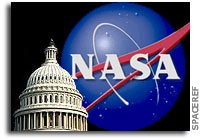Featured Legislation – The NASA Authorization Act of 2010

The bill would authorize NASA appropriations for FY 2011-2013 with the same top-line budget values as the President’s request to Congress. The bill would support an overall growth in science, aeronautics, and space technology and define a long-term goal for human space flight to expand a permanent human presence beyond low-Earth orbit. Key objectives of this goal would include full utilization of the International Space Station (ISS), determining the ability of humans to live in space for extended periods of time, maximizing the role of space exploration and technology in current and future missions, advancing knowledge and inspiring young people into higher education, and building upon international partnerships.
Human Space Flight. The bill would:
– Couple human space flight efforts to national and global needs and challenges;
– Provide a sustainable exploration program to incorporate new technologies and in-space capabilities;
– Require immediate development of a heavy-lift capability and continued support of an exploration crew vehicle to be capable of supporting missions beyond low-Earth orbit starting in 2016; and
– Support a sound performance and cost framework by maximizing use, where possible, of the workforce, assets, and capabilities of the Space Shuttle, Constellation, and other NASA programs.
Space Technology. The bill would:
– Invest in exploration technologies and robotic capabilities that are tied to the overall exploration framework and support U.S. innovation and competitiveness.
Commercial Cargo and Crew. The bill would:
– Continue to support commercial cargo development and provide additional funds to meet launch infrastructure requirements and accelerate development activity; and
– Expand the Commercial Crew Development Program in 2011 for concept development and supporting activities, while requiring a number of studies to ensure effective oversight of the potential initiation of a commercial crew capability procurement program no earlier than 2012.
International Space Station. The bill would:
– Extend the ISS to at least 2020 to support international and commercial collaboration and growth, research, and technology development to maximize the scientific return on the significant investment in the ISS;
– Establish an independent non-profit to work with NASA to fully develop the ISS U.S. segment as a National Laboratory; and
– Require an assessment of ISS requirements for parts and equipment needed to ensure its full functionality through 2020.
Shuttle Retirement and final “Launch on Need” Mission. The bill would:
– Authorize an additional Shuttle flight, contingent on a safety review, to provide necessary support for the extension of the ISS.
Science and Aeronautics. The bill would:
– Protect a balanced portfolio for NASA, including full funding of aeronautics and Earth and space science.
Education. The bill would:
– Support new education initiatives, such as teacher training programs, to reinforce NASA’s role in developing a workforce with strong science, technology, engineering, and mathematics skills; and
– Increase the investment in NASA EPSCoR (Experimental Program to Stimulate Competitive Research) and NASA Space Grant program.
Rescoping and Revitalizing Institutional Capabilities. The bill would:
– Require NASA to examine alternative management models for NASA’s workforce, centers, and capabilities, while enforcing short-term prohibitions on major center displacements and reductions-in-force until the study is completed.








